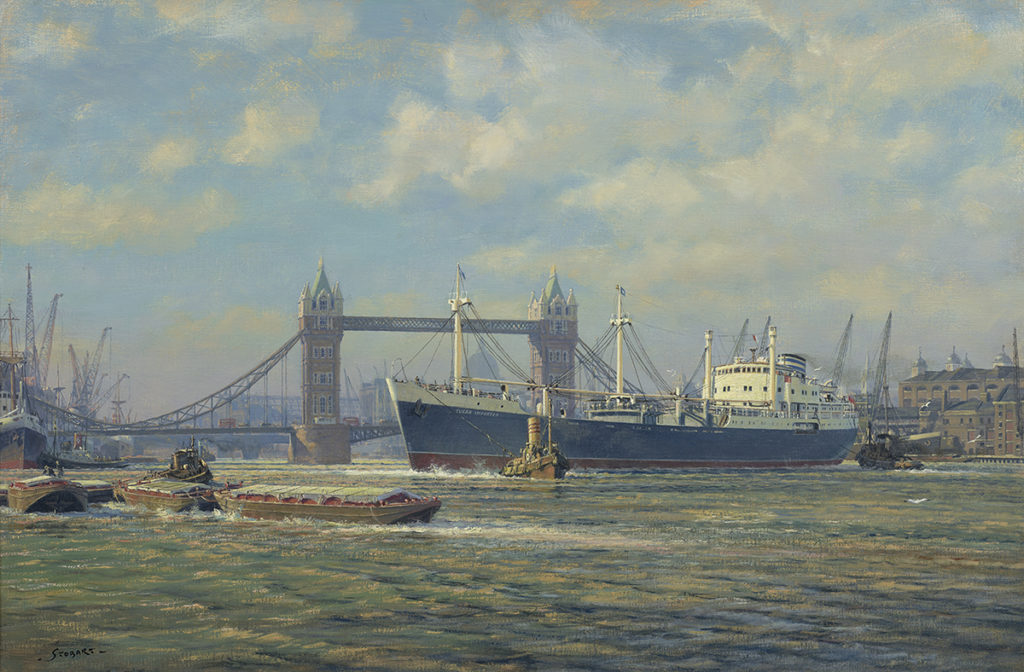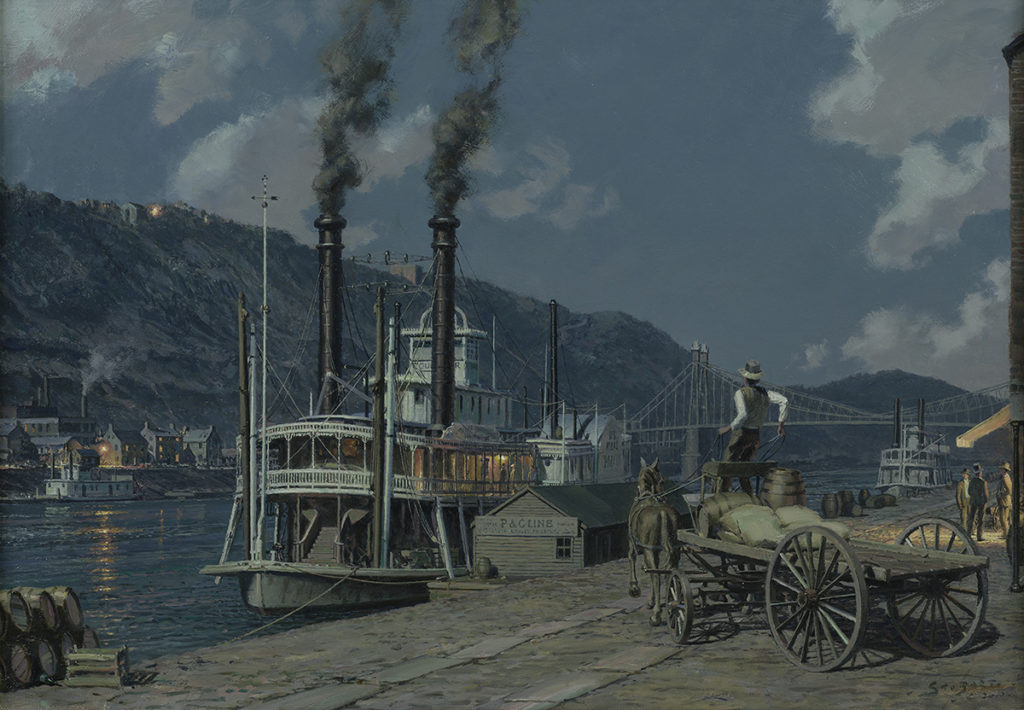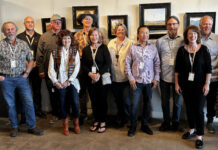Today we are saddened to report on the death of renowned artist John Stobart, who lived to be 93 and pursued his dream despite being once told, “You’re never going to put bread on the table with that kind of work.”
John was a plein air artist and an icon, known for his incredible maritime paintings.

“John was a giant, a legend, one of the most important artists of our times,” said Publisher Eric Rhoads. “He was a leader, an encourager of younger artists, and a brilliant businessman. He was known worldwide because of his PBS show WorldScape. He was a dear friend and I’ll miss him.”

Rehs Gallery has reported:
Born in Leicester, England, John was surrounded by the beautiful countryside and developed an early appreciation for the landscape… he always considered himself a landscape painter at heart. But at the age of 8, a visit to his grandmother’s home in the north allowed him an excursion to the port of Liverpool – at the time, the busiest port in England. This sparked his lifelong desire to capture the excitement of world trade that comes to life in a port. John would go on to study at the Derby College of Art and the Royal Academy in London, where he developed his skills in composition and perspective.
After that first exposure to a busy port, John’s passion for the sea and ships grew, leading him to pursue a career in maritime art. Shortly after completing his service in the Royal Air Force, John received a gift from his father; a ticket to board a ship destined for Cape Town, South Africa – his first ocean voyage. The adventure provided the young artist with a detailed understanding of how ships and ports function on a daily basis. Around this time, John first had the idea that British shipping companies might be interested in paintings of their ships in exotic port cities… not only was he right, but this idea laid the foundation for John’s entire body of work.
By the early 1960s, shipping companies weren’t just buying his paintings, but commissioning works and sponsoring his travel overseas. If you ever had the chance to speak with John, he would likely tell you his “life was a series of miracles.” One of the most notable of these miracles happened early in his career… on a train ride from Toronto to New York City, John unknowingly befriended Donald Holden, the editor of American Artist Magazine. That unlikely meeting would lead him to Kennedy Galleries, which would host John’s first solo exhibition in 1967.
John became known for his meticulous attention to detail and incredible ability to capture the atmosphere and mood of historic ports. He quickly gained a reputation as one of the best in his field and was soon exhibiting his paintings in galleries throughout North America and Europe. In 1970, John emigrated to the United States and settled in the coastal town of Darien, Connecticut. Later, while the family lived in the Washington, D.C. area, he established the Atlantic Gallery near his Georgetown studio – the first of five galleries. He continued to produce stunning works that captured the imagination of collectors and enthusiasts alike. His compositions include views of iconic locations such as Boston Harbor, New York Harbor, San Francisco Bay, Pittsburgh, Hilton Head, Venice, London, Bermuda, Cape Town, and many others; his paintings are not just works of art but also historical records of a bygone era.

While John enjoyed making his ships and structures historically precise, he could not hold back his deep love for friends and family. Throughout his oeuvre, he consistently renamed dinghies and port-side shops after those who meant the most to him. Several of his later works are also fondly known for their inclusion of a well-hidden wine bottle. John would routinely tell the tale of the time his son, Bill, exclaimed that a supposedly completed painting was, in fact, incomplete as his father forgot the bottle! John had not realized Bill was paying such close attention, but it became their little game from then on. Though these details are subtle, they are incredibly meaningful and a testament to the kind of person John was.
In 1978, John played a pivotal role as one of the founding members and Vice President of the esteemed American Society of Marine Arts (ASMA), a distinguished organization that is dedicated to acknowledging, fostering, and advancing the field of marine art and maritime history. Through its various initiatives, ASMA aims to promote collaboration and open dialogue among artists, art teachers, art students, publishers, and other individuals engaged in creative pursuits that pertain to marine art and the rich history surrounding it.
Over the course of his career, John received numerous awards and honors for his contributions to the art world; among them was his election to the prestigious National Academy of Design in New York and the Royal Society of Marine Artists in 1979. During the 1990s, the government of Bermuda acknowledged him with the Order of Merit for his impact on the island’s maritime heritage. In 1997, he was awarded an honorary doctorate from the Marine Maritime Academy, and the American Society of Marine Artists presented him with the Award of Excellence, the society’s highest honor. In 2008, he returned home to Derby, U.K., where he was awarded an Honorary Doctor of Letters from the University of Derby, which had subsumed the Derby College of Art years earlier.
In addition to his artistic achievements, John was a generous philanthropist. He established the Stobart Foundation to support recently graduated artists, particularly those influenced by the history and tradition of the plein air painters, in their transition to becoming professional artists. John recognized, from personal experience, that this time is crucial in an artist’s development. His goal was to offer an environment of support and provide financial assistance at a time when the artist’s energies and resources were at their lowest point. Despite his overwhelming success, John remained humble and approachable and was widely admired for his generosity.
John’s legacy will live on through his paintings, which will continue to inspire artists and captivate audiences for generations to come, as well as through the works of the Stobart Foundation recipients.
John Stobart is survived by his wife Anne, whose devotion to the man and his career was unbounded, his three children, Diana Wild, Elizabeth Stobart, and Bill Stobart from his first wife Kay Stobart; his son-in-law Fred Wild, daughter-in-law Sherry Stobart, three grandchildren Sam, Lilly and Zoe, and three great-grandchildren Layana, Lucas, and Reggie. He will be deeply missed by his family, friends, and the countless people around the world who admired his work and were touched by his kindness.
Donations in John Stobart’s memory may be made to The Stobart Foundation.
“I’ve always wanted to help other people because having a talent like that…it’s very selfish to think that you’re just going to be using it for yourself.” ~John Stobart on teaching art (Plein Air Podcast with Eric Rhoads, Episode 149)





GREAT ARTICLE TOBI ABRAMS